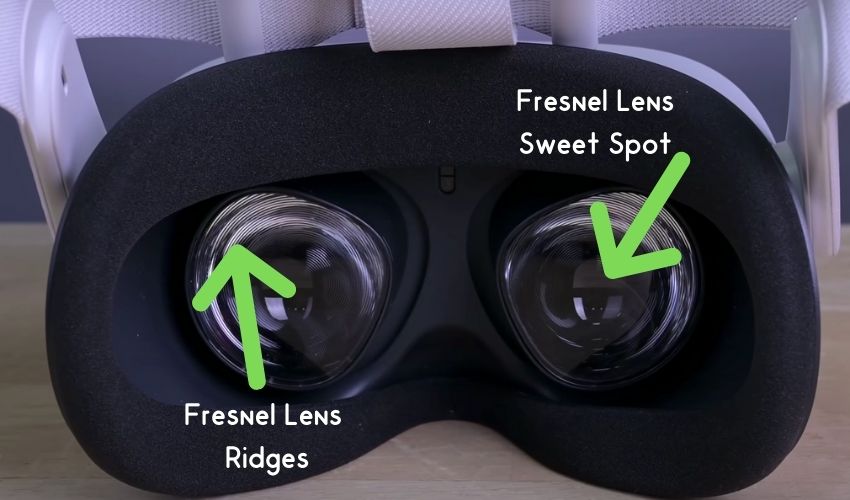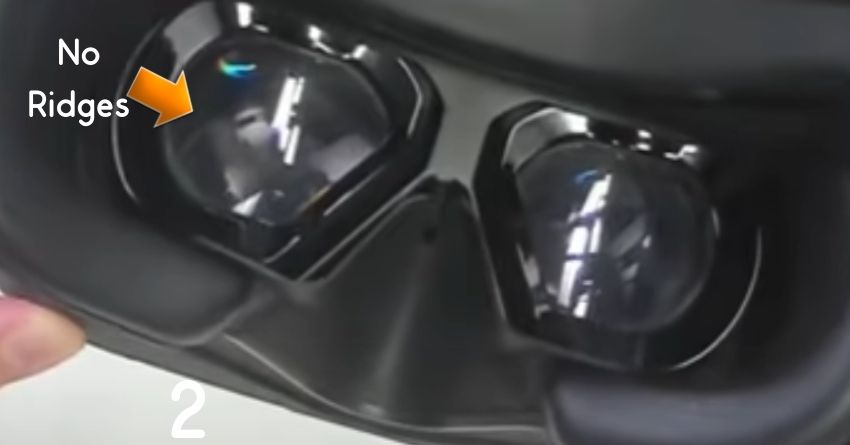The short answer is that the best lens for VR likely hasn’t been invented yet.
While the current tech inside of a VR headset, isn’t that different from smartphones. Some pretty big leaps need to get made before it’s hard to visually distinguish VR from reality. And the lenses are a big part of the system that will need to change.
That said, in 2022, your choices are effectively Fresnel lenses, Aspheric lenses, and soon Meta will release Pancake lenses with its upcoming Cambria headset.
So what are the benefits and drawbacks of each? And which is better? Are they worth paying more for? Let’s find out.
Nearly All Headsets Use Fresnel Lenses in 2022
While there are slight differences in the design of fresnel lenses between headsets, most headsets have the exact same lens tech as of 2022. So this probably isn’t a choice that you have to make… At least until you enter the high-end of the market.
| Year Released | Headset | Lens Type |
| 2016 | HTC VIVE | Fresnel |
| 2020 | STARVR ONE | Fresnel |
| 2016 | Oculus Rift CV1 | Fresnel |
| 2020 | Pimax Artisan | Fresnel |
| 2019 | Valve Index | Fresnel |
| 2020 | HTC Vive Pro | Fresnel |
| 2019 | Oculus Rift S | Fresnel |
| 2020 | Oculus Quest 2 | Fresnel |
| 2020 | HP Reverb G2 | Fresnel |
| 2021 | Varjo Aero | Aspheric |
| 2022 | Pico Neo 3 Link | Fresnel |
| 2022? | Project Cambria? | Pancake??? |
Since everybody uses fresnel lenses those must be the best right? Ehhh, it depends on how you define best. They’re definitely the cheapest, which is why everybody uses them.
Originally designed in the early 1800’s for use in lighthouses, fresnel lenses have large aperture, short focal length, and use significantly less material than other lens types while allowing most of the light to pass through. They can also easily be made from cheap plastics. Being lightweight and cheap to produce is what made them perfect for the first generation of VR headsets.
But are they the best lens tech available? What’s the downside? Well, the main downside is that they have ridges in their design that scatter light as your eyes drift from the center. This means if you’re not looking directly into the center of the lens you will experience “god rays” or just a lot of scattered light coming from the ridges. If you own a headset simply look at the ridges and you’ll see what I mean.

Do these ridges in their design mean fresnel lenses are doomed and will be replaced with better technology in the future? Honestly, yes. That said, it might take a few years for us to scale a more lightweight and cheaper alternative. So fresnel lenses are likely to be in select headsets for years to come.
Aspheric Lenses
As of 2022 the $2000+ Varjo Aero is the only commercially available headset I’m aware of that ships with aspheric lenses (although I’m sure I’m missing one). It’s rare to see.

And it’s rare largely because of weight and cost. These are made with real glass and they’re similar to eyeglass technology that’s been around for a very long time. For those of you who have ever bought a pair of glasses, you have a rough idea what these types of lenses cost.
That said, if you’re willing to pay a premium they’re definitely superior to fresnel lenses in a lot of ways. The big one being that there are no ridges in the lens design that scatters light. Meaning there’s a wider sweet spot that you can look into and still see a clear picture.
Where you’ll really notice the difference here is with headsets that have a wide field of view. The Quest 2’s field of view is so narrow that you’re pretty much always looking right down the center. But as you expand the field of view there’s more light coming in from the sides that the fresnel lenses would scatter.
Pancake Lenses
Pancake lenses decrease the distance needed between your eyes and the display by bouncing light with the lens. They do this by folding lenses together in a curve.
The primary benefit of pancake lenses with VR is that is allows devices to be thinner and lighter. Plus, it eliminates the god rays you’ll experience with the ridges on Fresnel lenses.
The downside to pancake lenses is that they allow less light to pass through them because of how they bounce light around within the lens itself. This is a real problem in the VR industry because the less light that passes through the lenses the bright the display has to get. And the brighter the display has to get the bigger the battery needs to be.
And so the size gains you achieved by reducing the space needed for the lenses can easily be destroyed by the larger battery.
The Future of VR Lens Tech
This is where I get a bit out of my league. Optics for VR actually has a lot of issues it needs to work out. Such as.
- How to prevent light scattering as you increase the field of view.
- How to make the lenses cheaply to keep headset costs reasonable.
- How to keep the weight down so headsets are less bulky.
- How to allow most of the light to pass through the lens so that you don’t drain the battery by running a brighter screen.
- How to allow prescription inserts so people with less than perfect vision can use the tech.
- How to adjust the focal length to you can see high resolution right in front of you and far away.
And probably a bunch of other problems I’m not even aware of. It’s very complex technology and whoever figures it out the fastest is likely to get a big lead in the VR hardware market for years to come.
In the short term? I expect we’ll continue to see Fresnel lenses in cheaper VR headsets and a combination of aspheric and pancake lenses in high-end devices.


